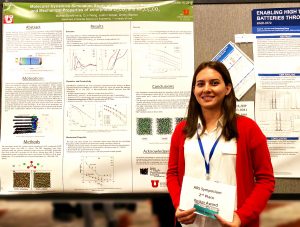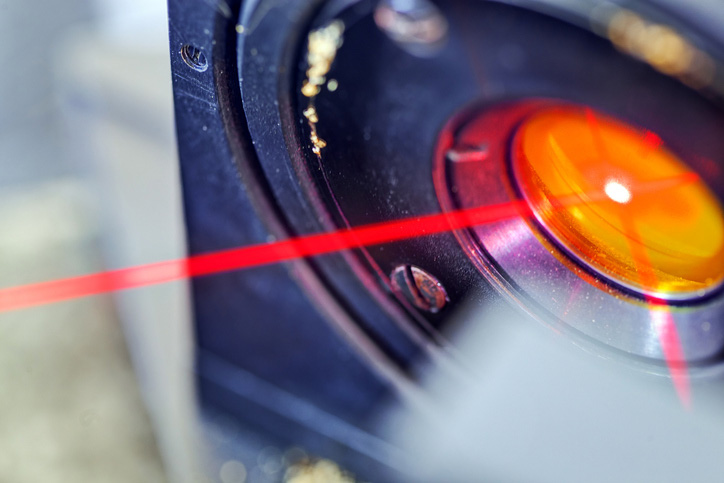 The U.S. Department of Energy (DOE) recently announced $209 million in funding for 26 new laboratory projects focusing on electric vehicles, advanced batteries, and connected vehicles. DOE’s Argonne National Laboratory introduced Li-Bridge, a new public-private partnership to bridge gaps in the domestic lithium battery supply chain. Advanced lithium-based batteries play an integral role in 21st century technologies such as electric vehicles, stationary grid storage, and defense applications that are critical to securing a clean energy future. The projects support goals to make the United States a global leader in electric vehicle and battery innovation; advance the development of these technologies to save families money; lower carbon pollution; and create high-quality jobs. (more…)
The U.S. Department of Energy (DOE) recently announced $209 million in funding for 26 new laboratory projects focusing on electric vehicles, advanced batteries, and connected vehicles. DOE’s Argonne National Laboratory introduced Li-Bridge, a new public-private partnership to bridge gaps in the domestic lithium battery supply chain. Advanced lithium-based batteries play an integral role in 21st century technologies such as electric vehicles, stationary grid storage, and defense applications that are critical to securing a clean energy future. The projects support goals to make the United States a global leader in electric vehicle and battery innovation; advance the development of these technologies to save families money; lower carbon pollution; and create high-quality jobs. (more…)
 A research strategy for ocean carbon dioxide removal and sequestration
A research strategy for ocean carbon dioxide removal and sequestration
This summer, you may find yourself on the shore’s edge admiring the vastness and beauty of the ocean. There’s a lot going on in there! According to The National Academies of Sciences, Engineering, and Medicine, the ocean covers about 70% of the Earth’s surface and buffers a large fraction of anthropogenic CO2 emissions—removing roughly 55% of emitted CO2 naturally. BUT, it may be possible to enhance both the uptake and longer-term sequestration potential of these processes. The National Academies of Sciences, Engineering, and Medicine is looking to do just that and are currently soliciting nominations for individuals to serve on the Committee on A Research Strategy for Ocean Carbon Dioxide Removal and Sequestration. (more…)
236th ECS Meeting Best Poster and Presentation Winners
Posted on November 15, 2019 by Frances Chaves
Mahsa Ebrahiminia (Photo by Gleb Yushin)
ECS is pleased to announce the winners of symposia-funded best presentation awards from the 236th ECS Meeting in Atlanta. Through the generous funding of individual symposium sponsors, several awards of this type are presented at every ECS meeting. You are invited to celebrate the excellent work of these authors:
A05 – Lithium Ion Batteries – Best Poster Award Winners
Thank you to Livent, Arbin Instruments, and Gamry Instruments, Inc. for their generous sponsorship of this symposium.
Mahsa Ebrahiminia, University of Utah: “Molecular Dynamics Simulation Study of Ion Transport, Structural and Mechanical Properties of Li2CO3 and Mn-Li-CO3” (more…)
 Christopher Jannuzzi, Executive Director and CEO of The Electrochemical Society (ECS), is featured in SciTech Europa Quarterly, a digital publication bringing together the key voices in the European scientific community and the leading trends in science, research and innovation. Jannuzzi describes the distinguished history of ECS, which was founded in 1902 and has grown to a society with over 8,000 members in 80 countries. The core mission remains the same: to advance theory and practice at the forefront of electrochemical and solid state science and technology, and allied subjects. However, with 13 electrochemistry and solid state science and technology divisions, the application—and vital significance—of electrochemistry has grown exponentially. The research published in ECS journals is of huge importance to the future of our planet. ECS makes it freely available to all readers—and free for authors to publish—through a bold and exciting open access initiative, “Free the Science.” Read the full article in SciTech Europa Quarterly now.
Christopher Jannuzzi, Executive Director and CEO of The Electrochemical Society (ECS), is featured in SciTech Europa Quarterly, a digital publication bringing together the key voices in the European scientific community and the leading trends in science, research and innovation. Jannuzzi describes the distinguished history of ECS, which was founded in 1902 and has grown to a society with over 8,000 members in 80 countries. The core mission remains the same: to advance theory and practice at the forefront of electrochemical and solid state science and technology, and allied subjects. However, with 13 electrochemistry and solid state science and technology divisions, the application—and vital significance—of electrochemistry has grown exponentially. The research published in ECS journals is of huge importance to the future of our planet. ECS makes it freely available to all readers—and free for authors to publish—through a bold and exciting open access initiative, “Free the Science.” Read the full article in SciTech Europa Quarterly now.
According to the Federal Aviation Administration, nearly 7,000 laser strikes on aircrafts were reported in 2017.
“In cities like Chicago this problem is real as people are shining laser pointers on aircrafts during critical phases of flight, which is a big nuisance to pilots,” said Jason Keleher, a professor and chair of chemistry at Lewis University, who was approached by the aviation department at Lewis University to collaborate on a solution to this growing problem .
“Is it a bunch of kids? Is it accidental? Is somebody just like, ‘I bet you can’t hit that plane with those lasers.’ It’s really hard to identify who’s actually doing it. It’s a very interesting problem,” said Keleher, one he, the project’s principal investigator, was prepared to solve.
Keleher explains that although the lasers don’t cause permanent eye damage to pilots as they maneuver the aircraft, it does cause temporary flash blindness which may make it difficult for pilots to see control systems as they prepare for take-off and landing. He explains it is similar to the way high beams can disorient a driver upon direct exposure.
(more…)
Lesser-Known Relative of the Laser Could Leave the Lab Soon
Posted on February 9, 2018 by Amanda Staller Researchers may have found a way to solve the weakness of a type of light source similar to lasers. The alternative light source could lead to smaller, lower-cost, and more efficient sources of light pulses.
Researchers may have found a way to solve the weakness of a type of light source similar to lasers. The alternative light source could lead to smaller, lower-cost, and more efficient sources of light pulses.
Although critical for varied applications, such as cutting and welding, surgery and transmitting bits through optical fiber, lasers have some limitations—namely, they only produce light in limited wavelength ranges.
Now, researchers have modified similar light sources, called optical parametric oscillators, to overcome this obstacle.
Until now, these lesser-known light sources have been mostly confined to the lab because their setup leaves little room for error—even a minor jostle could knock one out of alignment.
Novelty in Science – Real Necessity or Distracting Obsession?
Posted on January 3, 2018 by Amanda StallerBy: Jalees Rehman, University of Illinois at Chicago
 In a recent survey of over 1,500 scientists, more than 70 percent of them reported having been unable to reproduce other scientists’ findings at least once. Roughly half of the surveyed scientists ran into problems trying to reproduce their own results. No wonder people are talking about a “reproducibility crisis” in scientific research – an epidemic of studies that don’t hold up when run a second time.
In a recent survey of over 1,500 scientists, more than 70 percent of them reported having been unable to reproduce other scientists’ findings at least once. Roughly half of the surveyed scientists ran into problems trying to reproduce their own results. No wonder people are talking about a “reproducibility crisis” in scientific research – an epidemic of studies that don’t hold up when run a second time.
Reproducibility of findings is a core foundation of science. If scientific results only hold true in some labs but not in others, then how can researchers feel confident about their discoveries? How can society put evidence-based policies into place if the evidence is unreliable?
Recognition of this “crisis” has prompted calls for reform. Researchers are feeling their way, experimenting with different practices meant to help distinguish solid science from irreproducible results. Some people are even starting to reevaluate how choices are made about what research actually gets tackled. Breaking innovative new ground is flashier than revisiting already published research. Does prioritizing novelty naturally lead to this point?
It’s Now Tougher (and More Expensive) to Find Big Ideas
Posted on September 20, 2017 by Amanda Staller Big ideas are getting harder and harder to find, and innovations have become increasingly massive and costly endeavors, according to new research.
Big ideas are getting harder and harder to find, and innovations have become increasingly massive and costly endeavors, according to new research.
As a result, tremendous continual increases in research and development will be needed to sustain even today’s low rate of economic growth.
This means modern-day inventors—even those in the league of Steve Jobs—will have a tough time measuring up to the productivity of the Thomas Edisons of the past.
Nicholas Bloom, senior fellow at the Stanford Institute for Economic Policy Research and coauthor of a paper released this week by the National Bureau of Economic Research, contends that so many game-changing inventions have appeared since World War II that it’s become increasingly difficult to come up with the next big idea.
“The thought now of somebody inventing something as revolutionary as the locomotive on their own is inconceivable,” Bloom says.
“It’s certainly true if you go back one or two hundred years, like when Edison invented the light bulb,” he says. “It’s a massive piece of technology and one guy basically invented it. But while we think of Steve Jobs and the iPhone, it was a team of dozens of people who created the iPhone.”
By: Timothy H. Dixon, University of South Florida
 This summer I worked on the Greenland ice sheet, part of a scientific experiment to study surface melting and its contribution to Greenland’s accelerating ice losses. By virtue of its size, elevation and currently frozen state, Greenland has the potential to cause large and rapid increases to sea level as it melts.
This summer I worked on the Greenland ice sheet, part of a scientific experiment to study surface melting and its contribution to Greenland’s accelerating ice losses. By virtue of its size, elevation and currently frozen state, Greenland has the potential to cause large and rapid increases to sea level as it melts.
When I returned, a nonscientist friend asked me what the research showed about future sea level rise. He was disappointed that I couldn’t say anything definite, since it will take several years to analyze the data. This kind of time lag is common in science, but it can make communicating the issues difficult. That’s especially true for climate change, where decades of data collection may be required to see trends.
A recent draft report on climate change by federal scientists exploits data captured over many decades to assess recent changes, and warns of a dire future if we don’t change our ways. Yet few countries are aggressively reducing their emissions in a way scientists say are needed to avoid the dangers of climate change.
While this lack of progress dismays people, it’s actually understandable. Human beings have evolved to focus on immediate threats. We have a tough time dealing with risks that have time lags of decades or even centuries. As a geoscientist, I’m used to thinking on much longer time scales, but I recognize that most people are not. I see several kinds of time lags associated with climate change debates. It’s important to understand these time lags and how they interact if we hope to make progress.
Tracing the Links Between Basic Research and Real-World Applications
Posted on August 11, 2017 by Amanda StallerBy: Benjamin F. Jones, Northwestern University and Mohammad Ahmadpoor, Northwestern University

Image: CC0 Public Domain
What does hailing a ride with Uber have to do with 19th-century geometry and Einstein’s theory of relativity? Quite a bit, it turns out.
Uber and other location-based mobile applications rely on GPS to link users with available cars nearby. GPS technology requires a network of satellites that transmit data to and from Earth; but satellites wouldn’t relay information correctly if their clocks failed to account for the fact that time is different in space – a tenet of Einstein’s general theory of relativity. And Einstein’s famous theory relies on Riemannian geometry, which was proposed in the 19th century to explain how spaces and curves interact – but dismissed as derivative and effectively useless in its time.
The point is not just that mathematicians don’t always get their due. This example highlights an ongoing controversy about the value of basic science and scholarship. How much are marketplace innovations, which drive broad economic prosperity, actually linked to basic scientific research?
It’s an important question. Plenty of tax dollars and other funds go toward the research performed in academic centers, government labs and other facilities. But what kind of return are we as a society recouping on this large investment in new discoveries? Does scientific research reliably lead to usable practical advances?



